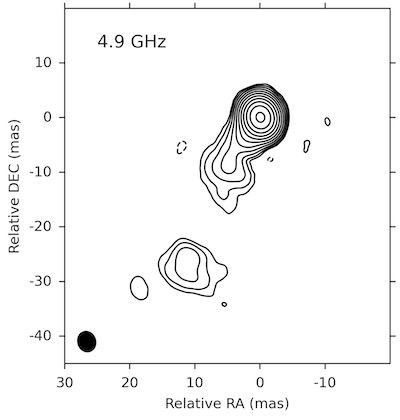by Cristina Nanci (Università di Bologna & Istituto Nazionale di Astrofisica - Istituto di Radioastronomia (INAF - IRA))

spatially coincident neutrino detection. Observations like this, and
subsequential monitoring of the sources, are extremely important
for studying morphological changes in blazar jets and their link
with the particle acceleration processes.
Credit: Nanci et al. 2022.
For a long time, the European VLBI Network (EVN) facilities served a crucial role in the investigation of the physics of powerful radio-loud AGN called blazars. As part of my PhD, I am exploiting the EVN's high-resolution capabilities to study the parsec-scale regions of these sources in particular as a possible site of neutrino production. This is a rather new field of research, started with decades of theoretical predictions, but only recently refreshed thanks to some interesting observational indications. In 2017 indeed, in the close proximity of a neutrino event, the gamma-ray blazar TXS 0506+056 was detected while undergoing a flare. The coincidence of the neutrino detection with the flare from this source confirmed for the first time the association of a neutrino with an astrophysical source. After that, the interest has significantly grown in the whole astronomical community which is now laying the foundation for multimessenger astronomy studies. Among other opportunities, investigating blazars as neutrino emitters can provide us with a new and more complete picture of the processes occurring in such cosmic accelerators. As a PhD student, I am excited to start my research career contributing to this emerging and promising field.
In order to investigate blazars as neutrino emitters, my collaborators and I proposed EVN and VLBI follow-up observations of neutrino events. VLBI analysis of TXS0506+056 has shown a probable link between radio properties in the jet of this source and the processes of particle acceleration. Our goal is now to detect the recurrence of these kinds of features in other neutrino emitters candidates. Then we aim to investigate source-by-source characteristics and, in the end, build a statistical collection of blazars-neutrino-counterparts.
In the last years, we submitted three trigger proposals to EVN, dedicated to the neutrino events of 2020, 2021 and 2022 and, the last submitted, dedicated to 2023 events. Unlike regular proposals, in which the targets and the time of the observations are well defined, the trigger proposals ask for “triggered” observations that can be activated when some specific criteria are met. The number of neutrino events to follow and the trigger criteria are defined and justified in the proposal and then evaluated by the EVN committee. All our proposals up to now were welcomed by an enthusiastic committee that agrees with us on the importance of approaching the search for neutrino emitters with high-resolution observations. The first collection of follow-ups has already revealed intriguing results. For example, the blazar TXS1100+122 seems to have experienced an enhanced state of activity when the neutrino IC200109A was detected close to it. Thanks to the EVN observation we were able to capture a snapshot of what could be the process of neutrino production just when it is happening (see Figure 1). Now, it only remains to wait for other new and exciting neutrino events and the results of the EVN follow-ups of their candidate counterparts.
 Cristina Nanci is a third-year-PhD student at the University of Bologna. Her PhD project aims to study relativistic jets in AGN by exploiting the complementary information from radio and gamma rays observations. She is a member of the VLBI group at the Institute of Radioastronomy (IRA) and of the MAGIC Collaboration.
Cristina Nanci is a third-year-PhD student at the University of Bologna. Her PhD project aims to study relativistic jets in AGN by exploiting the complementary information from radio and gamma rays observations. She is a member of the VLBI group at the Institute of Radioastronomy (IRA) and of the MAGIC Collaboration.